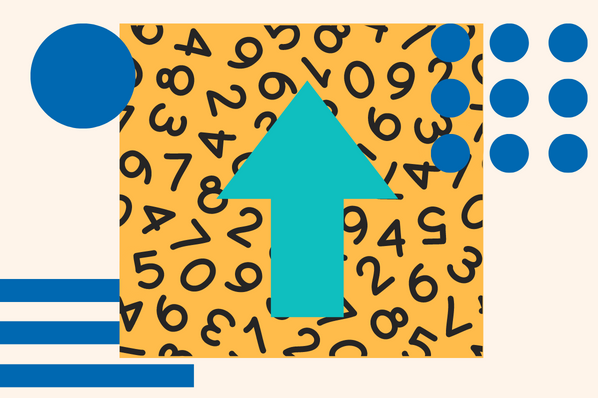If you've ever played the popular word game Mad Libs, then you're familiar with the concept of frameworks. Instead of writing the story from scratch, you're given the structure of the story with different areas to customize. This saves you time because you’re taking a template and repurposing it for your needs — or for your entertainment, in the case of Mad Libs.

JavaScript frameworks provide the same function. Instead of creating all of your application's infrastructure and functionality yourself, you can turn to frameworks to lay the foundation of your web application and build up. Let's take a closer look at this concept.
What is a JavaScript framework?
A JavaScript framework is a collection of pre-written code built to support applications and provide benefits that plain JavaScript does not offer on its own.
If the idea of frameworks still isn't clear, consider a tent. You build a frame to provide the tent's structure. You can then add whatever you want on the outside and the inside of the tent. Obviously, JavaScript frameworks aren't physical structures like in our tent, but the concept is similar.
Before diving into the most popular JavaScript frameworks, let's take a moment to answer two common questions.
How is a JavaScript framework different from a JavaScript library?
JavaScript libraries are collections of code designed for specific use cases.
For example, Day.js is a library dedicated to simplifying the usage of dates in JavaScript — which can be complex even for seasoned developers. Another popular JavaScript library is jQuery, which streamlines the syntax for document object model (DOM) traversal, event handling, animations, and other common tasks.
Frameworks, on the other hand, are built to fulfill multiple functions and form the backbone of a web application. Many frameworks, like Angular, architect the entire site tree. Meaning, they are used for the entire front end of the application. Others, like Vue.js, support incremental use, meaning your application can use the framework in limited amounts.
You will likely use libraries within your application for specialized use cases your framework doesn't cover. Think back to those pesky dates with Day.js. You don't need to use this library in views that don't include dates.
On the other hand, if your application is built with Angular, then the page template is written in Angular's syntax regardless of what functions you leverage. In contrast, you can call Day.js in files where you need it and leave it out of files where you don't.
Why use a JavaScript framework?
Since frameworks are built on top of JavaScript, you can achieve everything a framework does with normal JavaScript. However, why duplicate all that effort when someone has already done the legwork? This points to the main benefit of using a JavaScript framework: enhanced functionality without requiring you to write code from scratch.
For example, React and Vue.js both use the virtual document object model (DOM). The virtual DOM is faster at manipulating HTML elements because it only updates the elements that have been changed. Regular JavaScript, on the other hand, will render the entire DOM again regardless of the size of the change. This means that React and Vue.js are faster for websites and applications that have lots of interactive features.
The key is selecting the right framework to meet the needs of your project. Let’s examine the five most popular frameworks to inform your decision.
Popular JavaScript Frameworks
- Node.js
- React
- Vue.js
- Angular
- Ember.js
Popular JavaScript Frameworks
- Node.js
- React
- Vue.js
- Angular
- Ember.js
1. Node.js
.png?width=650&name=JavaScript%20Frameworks%20(V7%20-%20CMS%20upload).png)
Released in 2009, Node.js is an open-source, runtime environment built to execute JavaScript outside of a browser, which distinguishes it from the front-end focused frameworks in the following sections. Node currently has more than 83,000 stars on GitHub.
The framework is designed to build network applications at scale. To support this goal, Node is optimized for efficient handling of resources and integrates well with other frameworks and libraries. Built on Google Chrome's JavaScript Engine, Node leverages asynchronous loading from its APIs for faster responses. Another feature is the framework's ability to proxy some types of servers for more efficient testing.
A final benefit of Node is the Node Package Manager (NPM), a directory of over one million JavaScript libraries. These packages include server frameworks like Express, testing suites like Jest, Object-Document Mapping (ODM) solutions for SQL databases like Sequelize, and Object-Relational Mapping (ORM) solutions for NoSQL databases like Mongoose. NPM libraries can structure your entire web application, allowing your team to work in JavaScript across the full stack.
2. React
-3.png?width=650&name=JavaScript%20Frameworks%20(V7%20-%20CMS%20upload)-3.png)
Introduced in 2013, React has accrued more than 179,000 stars on GitHub, cementing its place as the second-most popular framework in this list. React is a fast, scalable, and reusable framework for building interactive user interfaces (UIs). Like Vue, React supports incremental use and uses the virtual DOM model for expedited updates of web page content. Naturally, it mainly supports the View piece of the Model-View-Controller (MVC) paradigm.
Unlike Vue, React is capable of supporting enterprise applications with ease. React introduced the idea of components, which are self-contained modules of code that are packaged for reuse. Components save developers time by writing code once and then using it across the application. Then, you only need to change the code in one location for updates.
React can be extended to servers to support server-side rendering versus rendering in the browser. The framework also supports JSX, which provides shorter and simpler syntaxes for common tasks versus normal JavaScript.
3. Vue.js
-2.png?width=650&name=JavaScript%20Frameworks%20(V7%20-%20CMS%20upload)-2.png)
Vue.js was released in 2014 and has accumulated more than 191,000 stars on GitHub, making it the most followed framework in this list. This growth is even more impressive considering it is the newest framework of the five.
Vue is a front-end JavaScript framework that is designed to be approachable, versatile, and fast with a core focus on building single-page applications (SPAs). One of its main advantages is its incremental use model, which allows the framework to be used in limited amounts versus other frameworks that require full adoption. Vue's central library focuses on the View layer of the MVC architecture and uses the virtual DOM model for fast updates without needing to reload the page.
The framework combines the template strategy of Angular with the componentization of React, allowing developers to write page templates in standard HTML and package these templates and other code into components for easy reuse and streamlined updates. Vue's reactivity system automatically updates the view to reflect new data as it's introduced. By supporting HTML and JSX, Vue is easy to learn for teams familiar with front-end languages.
4. Angular
.jpeg?width=650&name=JavaScript%20Frameworks%20(V7%20-%20CMS%20upload).jpeg)
Released in 2010, Angular is the original front-end JavaScript framework with more than 78,000 stars on GitHub. The framework's focus is on building efficient and sophisticated SPAs, and it supports MVC or Model-View-Whatever (MVW) architecture.
Angular uses data binding, which automatically synchronizes data between the database and the client, saving developers from having to define requests and responses when a user interacts with the UI. The framework also supports dynamic rendering with its JSON-based processor. Another key feature of Angular is its use of HTML templates so the browser can directly parse the file. Finally, Angular supports if conditions, loops, and local variables inside its templates to program how the web page's content renders.
One of the main benefits of Angular is that the framework relies on the browser to build the page, lightening the load on the application's server and leading to faster load times.
One drawback is that Angular is written in TypeScript, a variant of JavaScript, lengthening the time needed to onboard the framework.
5. Ember.js
-1.png?width=650&name=JavaScript%20Frameworks%20(V7%20-%20CMS%20upload)-1.png)
Ember.js was released in 2011 and has earned more than 22,000 stars on GitHub. Its focus is on building rich, interactive UIs no matter the size of the website, from SPAs up to enterprise applications.
Ember's development model is built around HTML and CSS, lowering the learning curve. The framework takes a component-based approach built off the Handlebars templating engine. One advantage of using Handlebars is that the templates update automatically with relevant data changes. It also offers the Ember Inspector tool for debugging and additional add-ons through its user-friendly API.
One advantage of the Ember framework is its focus on convention over configuration, meaning it prioritizes out-of-the-box functionality. This reduces the number of decisions the developer needs to make — which reduces the number of possible errors — but this comes at the price of customization.
Choose the Right Framework for Your Website
As you've seen, there is no “perfect” solution for all websites. Otherwise, why would there be more than one JavaScript framework? Each offers distinct benefits and fulfills different use cases. This also means that finding the best framework for your website depends on many factors. Let’s take a look at a few of them below.
1. Existing Toolstack
If you're just starting to build your site, then this factor isn't as critical. However, you should have at least selected JavaScript as your front-end programming language. If you're using Python, for example, then you should look into Python web frameworks like Django instead.
If you're looking at implementing a framework in an existing site, then the list of considerations is longer. For example, if your site was built on another framework, then you need to weigh the time and money required to refactor the existing code versus the benefits the new framework offers. As an alternative, you can implement a second framework that can be used incrementally alongside your existing framework.
2. Complexity
Some frameworks are built to support SPAs, and some are built to support large applications. Knowing the scope of your project will help you identify which camp your application falls into and which framework will better support your requirements.
3. Performance Requirements
Another tradeoff with frameworks is the speed of your website. Some are built to prioritize quick responses and updates, like React and Vue with their focus on the virtual DOM. However, if you need more built-in functionality and control, then a more robust framework like Angular would be a better approach.
4. Technical Competence
Some frameworks, like Vue and Ember, are designed to be easy to learn and implement. Others, like Angular, are more complicated but offer more features.
Depending on your comfort level with JavaScript, you may want to use a simpler framework so you can start using it sooner. However, if you're comfortable with programming or have the time to learn, then a complex framework may offer more benefits in the long run.
Frame the Problem to Find the Solution
Every website is unique. The subject matter, features, and functionality will change depending on your goals, and so should the technology you choose to create it. In most — if not all — cases, a JavaScript framework is a great way to enhance speed and functionality while not needing to learn a separate programming language
The first step is understanding your needs to better frame your requirements. With that awareness and the knowledge of the frameworks' unique attributes in hand, you'll be able to select the best one to supercharge your website's performance and user experience.
![Download Now: An Introduction to JavaScript [Free Guide]](https://no-cache.hubspot.com/cta/default/53/52e488f1-9b65-4968-b59f-38009a1c92a3.png)










